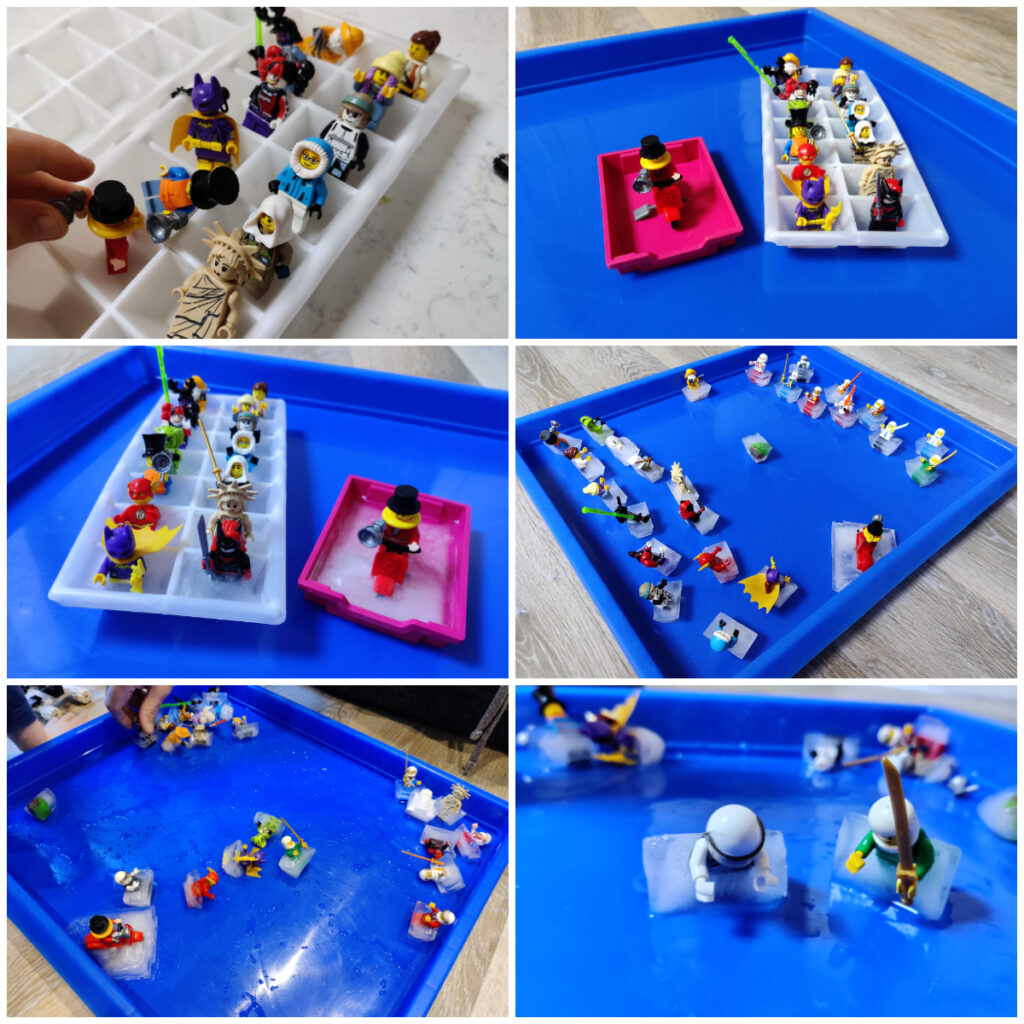Minifigure iceball
Have fun with your minifigures and explore the properties of ice in this simple science activity for home or school. Work indoors or outside.

Learning outcomes
You will be able to:
- Observe and describe the reversible change of water freezing to become ice and then thawing to become water again.
- Use appropriate language and scientific vocabulary related to changing state and when describing the properties of water and ice.
- Explore the effect of friction on movement.
You will need (per small group):
- 1 x Gratnells Art (A1) tray or shallow Gratnells (F1) tray (the surface should be polished clean before use)
- 8-10 x LEGO® minifigures or other small toy figures
- 1 x 10-12 section ice cube tray or a Gratnells 30-section tray insert
- 1 x small arts and crafts pom pom
- 1 x 200ml jug of drinking water
- Access to space in a freezer or outside temperatures that will fall below zero for ~3 hours
- Craft, recycled materials or a dry wipe pen to make two ~10 cm iceball goals on opposite walls of the tray
- Paper towels, tea towels or microfibre clothes to clear up any water drips or spills
What to do:
- Divide the minifigures into two distinct teams e.g. helmets and non-helmets, heroes and villains, hair and no hair (great grouping and sorting practice).
- Stand each minifigure into their own section of the ice cube tray. Tip: Raise their arms up to at least 90 degrees.
- Thoroughly soak one pom pom with water, place into one section of the ice cube tray.
- Carefully pour water into every section of the ice cube tray until three-quarters full. The water should come up to at least the minifigure’s waist but below their raised arms and should completely cover the pom pom. Observe, feel and describe the properties of the water.
- Transfer the ice cube tray to the freezer or, if the outdoor temperature is cold enough, to a safe outdoor space to freeze. If any minifigures topple over during transfer, stand them back up before you leave them.
- Make a prediction, what will happen to the water. Use appropriate scientific language and vocabulary.
- Make two ~10cm iceball goals and attach to opposite walls of the art tray or draw on two goals using a dry wipe pen.
- Leave for 2-3 hours in the freezer or over night if left to freeze outdoors.
- Check on your minifigures to make sure the water has completely frozen before carefully popping them out of the ice cube tray. What has happened to the water? Describe its properties.
- Place your minifigure ice cubes ‘players’ into the large Gratnells art tray in your chosen formation.
- Place the pom pom cube or ‘ice football’ into the middle.
- Play a game of ice football using the same methods as for table football or Subbuteo.
- Observe what is happening to the players. How do they move across the tray surface? Do they move in the same way if placed on a different surface e.g. carpet or vinyl flooring? What happens to the players over time? Use appropriate scientific language and vocabulary.
What is happening?
Key words: Solid, liquid, changing state, melting, freezing, water, ice, friction.
Water is a liquid, it can be changed to a solid by cooling it down until it freezes and becomes ice. Water freezes at 0oC. This change is reversible. If the solid ice is exposed to warmer temperatures, above 0oC, it melts and becomes liquid water again. Solid and liquid are two of the states of matter. When a liquid becomes a solid this is known as changing state, some changes of state are reversible, some are not.
Ice cubes glide over the smooth surface of the tray because of the low level of friction between the two surfaces. You may notice the ice cubes move more easily when they begin to melt a little and the surfaces become wet, reducing the levels of friction even further. Try sliding your ice cubes over different surfaces, for example, vinyl flooring, wooden desk tops or carpet tiles, what do you notice? Friction slows or stops moving objects. Be sue to collect your ice cubes up after your experiment and wipe up any drips or puddles to prevent slips and falls.
Other things to try…
- Colour the water/ice cubes using food safe colouring to identify the two teams more easily.
- If you don’t have minifigures, just use different coloured ice cubes to form the two teams.
- Sprinkle salt on to one of the iceball pitches? What do you think will happen? Why?
- Try ‘racing’ your ice cubes down sloped ramps covered in different materials to explore friction further. Rest your ramp on an upturned Gratnells tray and catch your ice cubes at the bottom of the slope in a second Gratnells tray.
- For more activities involving reversible changes of state, try making your own chocolate lolly pops or ice cream.
- Share your photographs/videos on social media using #WhatsInMyTray
Curriculum links:
The national curriculum in England. Key stages 1 and 2 framework document. 2013.
- Year 4. Science. States of matter.
- Year 5. Science. Properties and changes of materials.
- Year 5. Science. Forces. Friction.
Health & Safety
As with all Gratnells Learning Rooms What’s in my tray? activities, you should carry out your own risk assessment prior to undertaking any of the activities or demonstrations. In particular, care should be taken when handling ice immediately after it has been removed from the freezer. Any water drips or spillages should be wiped up immediately to reduce the risk of slips.

